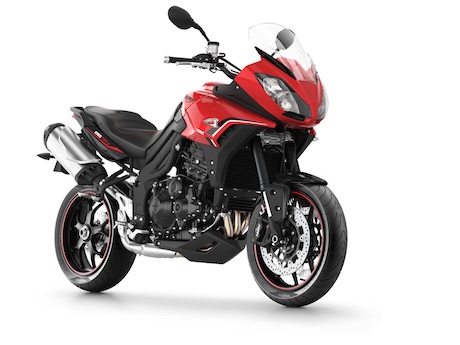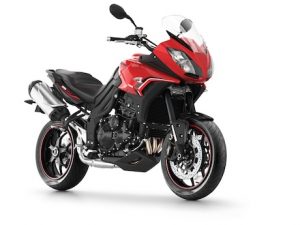Triumph has fine-tined its Tiger 1050 from adventure to sports.
The more sporty version has 50mm lower suspension and therefore a lower seat height, sportier suspension, a 14kg diet program and extra features such as switchable ABS and their first automated indicators.
The Triumph Tiger Sport arrives at the highly competitive list price of $15,990 (plus on-road costs) which is substantially lower than the SE at $17,590, albeit equipped with a luggage system and handguards. (It should be noted that Triumph is offering the SE at the run-out price of $16,590 rideaway.)
The new Tiger Sport is highly competitive among the vast array of big adventure tourers on the market, costing just $1000 more than the bargain Kawasaki Versys (although the Kwaka has traction control) and the cheapest of all the Euro models, most of which have a suite of electronic rider aids.
To highlight its sporty credentials the stylists have played around with the bodywork and arrived at a more lithe Tiger.
Its nose is sharper, its flanks leaner and the back end is cleaner, thanks largely to the single-sided swingarm like the Speed Triple which reveals the new wheel. Even the seat now gets red stitching to highlight its sporty credentials.
At the heart of any move to sport orientation is extra oomph in the engine and drivetrain.
While the triple-cylinder engine’s internals haven’t changed, the EFI software has new algorithms that make the throttle crisper, yet smoother, with more control.
Power is up about 7kW to 92kW at the same revs (9400rpm) with torque up 6Nm to 104Nm, a lot earlier at 4300rpm instead of 6250rpm.
At the same time, fuel economy has marginally improved by 1% to 6.6L/100km around town and by as much as 8% on the highway to 4.2L/100km.
The claimed highway cruising figure is achieved despite a slightly lower sixth gear ratio of 27:28 (previously 28:28) to increase wear and improve top-gear roll-on acceleration.
The Triumph Tiger Sport’s gearbox has always been a bit clunky although positive.
The box now has a new sliding selector fork shaft and selector drum with designed tracks for reduced shifting effort and a new selector mechanism and detent arm for lighter, more positive shifting.
While the mechanical transmission noises are now quieter, the Tiger growls, rather than purrs with a revised airbox and new stainless steel muffler giving it a menacing soundtrack.
Stopping the Tiger Sport in its tracks has been improved with 10mm bigger front discs and updated ABS hardware and software. Triumph claims stopping distances from 130km/h have reduced 6% in the dry to 69.4m and 7% t
Triumph’s engineers also made major changes to the chassis, not the least of which is the move to a single-sided swingarm which lightens the rear. Together with lighter wheels, it results in a 14kg lighter bike which affects handling.
The wheelbase has been increased 30mm for better high-speed stability and the trail has been increased 4.2mm for better cornering feedback and less bar input.
Likewise, the suspension has been tweaked.
Dropping the suspension 50mm and and recalibrating the front-end damping has helped reduce braking dive.
Meanwhile, the rear spring rate has been increased from 139N/mm to 160N/mm to compensate for the 39mm longer swingarm as well as a pillion and luggage.
Corrugations no longer send the front into a sideways shimmy and the bike feels more solid and planted on sweeping bends, even with mid-corner bumps.
Rider and pillion comfort is improved with the seat now 5mm lower to the ground, but also narrower so it is effectively 50mm lower for the up-and-over measurement.
If it’s still not low enough, you can order a 20mm lower accessory seat and although the seat has been reshaped for better comfort, there is also a comfort seat, now made with 3D mesh rather than gel which becomes too hot in Australian summers.
Riders will find the ergonomics slightly better with the flatter ProTaper-style handlebars 26mm closer and 11.5mm lower.
Pillion comfort is also better with ergonomically improved grab rails in the bodywork.
Tiger owners had complained that the seat wore out underneath from taking it off and putting it back on again. Triumph has listened and strengthened the connections on the Sport for longevity.
There is also now a generous 1.6 litres of storage space under the seat, fold-out attachment loops and U-lock stowage on the seat base.
The new on-board computer has controls on the left switchblock so you can toggle between all the instrument information without having to take your hands off the bars, including switching the ABS off.
Switch off the bike and turn it on again and it always defaults to ABS on.
The updated ABS feels much smother and less intrusive.
You can also select from a vast array of information (speed, trip, clock, fuel gauge, fuel range) and even change the parameters such as economy readout in mpg, l/100km or km/l. You can also switch the automatic indicators to manual and there is now a coded-key electronic immobiliser to keep your Tiger safe.
The new headlight has improved penetration and spread and the battery is now a larger YTX14 for easier starts after winter layoffs.
The Triumph Tiger Sport is no technological marvel like some of its big adventure touring peers, but a simple, honest, hardworking machine.
Triumph Tiger Sport 1050
Price: $15,990 (plus on-road charges)
Warranty: 2 years, unlimited distance
Servicing intervals: 10,000km
Engine: Liquid-cooled, 12 valve, DOHC, in-line 3-cylinder
Bore x stroke: 79 x 71.4mm
Displacement: 1050cc
Power: 92kW @ 9400rpm
Torque: 104Nm @ 4300rpm
Transmission: 6-speed, wet multi-plate clutch, chain drive
Suspension: Showa 43mm upside down forks with adjustable preload, rebound and compression damping, 140mm travel; Showa Monoshock with adjustable preload and rebound damping, 150mm rear wheel travel
Dimensions: Seat 830mm, wet weight 235kg, fuel capacity 20 litres, wheelbase 1540mm
Tyres: Front, 120/70 ZR 17. Rear, 180/55 ZR 17
Frame: Aluminium beam twin-spar, single-sided alloy swingarm with eccentric chain adjuster
Brakes: Front, twin 320mm floating discs, Nissin 4-piston radial calipers. Rear, single 255mm disc, 2-piston Nissin caliper. Switchable ABS
Fuel consumption: 6.6L/100km (urban), 4.2L/100km (highway)
Theoretical range: 470km
Colours: Diablo red, crystal white



